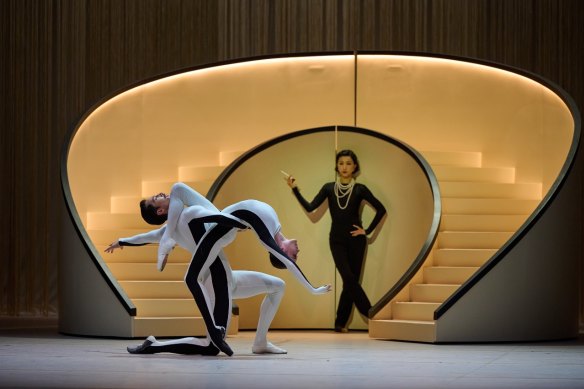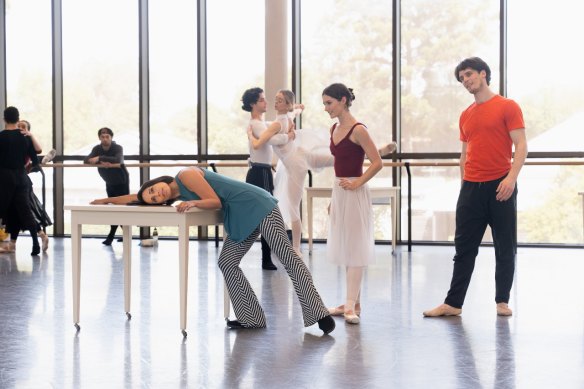By Nick Dent
When you hear the name Coco Chanel, do you think of the trailblazing couturier and entrepreneur who reinvented womenswear for the 20th century and freed women from the prison of the corset?
Or do you think of the Nazi collaborator and antisemite who spied for the Germans during the occupation of France and avoided prosecution thanks to her powerful friends?

Coco Chanel: The Life of a Fashion Icon opens at the Playhouse, QPAC on October 4.Credit: Shoccara Marcus
This very duality inspired Belgian-Colombian choreographer Annabelle Lopez Ochoa to create the ballet that is proving a blockbuster for Queensland Ballet and opens on October 4.
“It’s not a fairytale, she’s not a good girl,” says Lopez Ochoa, during a lunch break from rehearsals at the Thomas Dixon Centre.
“What do we do to survive? Characters are more interesting because they are not so clearly good or bad.
“It’s not up to me to judge my main character, I have to get under their skin and let the others have an opinion.”

Two dancers play the character of Logo – the intriguing Chanel symbol that has multiple meanings. Credit: Conrad Dy-Liacco
Coco Chanel: The Life of a Fashion Icon is a co-production that arrives in Brisbane following seasons at the Hong Kong Ballet and Atlanta Ballet.
With the unexpected departure of new artistic director Leanne Benjamin after fewer than six months in the role, Queensland Ballet’s acting AD, Greg Horsman, is relieved to have a success on his hands.
“People beyond our normal audience want to come and see this,” he says.
Horsman says he saw the production in Hong Kong last year before Li Cunxin’s retirement.
“It’s beautiful to look at, and has a fantastic score … It’s great for our audiences to see new full-length works created by world-renowned choreographers.”
Born in 1883, Chanel grew up in poverty in the Loire region of France. Dumped in a convent by her father after her mother’s death, she was taught to sew by a strict order of Catholic nuns.
With the help of her lover Etienne Balsan, she was able to open her first boutique in 1910.
“She was a serial seductress who became one of the strongest businesswomen in a man’s world,” Lopez Ochoa says.
Her innovations in fashion changed the female silhouette to allow freedom of movement – “and therefore the opportunity to work, and to be independent”.

Annabelle Lopez Ochoa rehearsing Coco Chanel: The Life of a Fashion Icon in Brisbane with Queensland Ballet.Credit: Angharad Gladding
“She wanted [fashion] to be elegant and it needed to be functional. She was a visionary, and that’s what she gave to women.”
But her legacy is tarnished by the fact she had an affair with a member of the Gestapo, Baron von Dincklage, and used the connection to attempt to wrestle ownership of her wildly successful perfume, Chanel No.5, away from its Jewish backers.
Friendship with Winston Churchill reportedly spared her from prosecution as a collaborator.
Ticket holders are being warned that the production includes Nazi symbols, and are encouraged to learn more at the Queensland Holocaust Museum. Horsman says Queensland Ballet dancers and staff have also been urged to do so.
“There’s a lot of sensitivity around Nazi symbols and glorifying that particular aspect, which I think the ballet handles cleverly,” he says.
Lopez Ochoa, who has previously made ballets about Frida Kahlo and Eva Peron, says she is making theatre, not a documentary.
“Everything that you see is an interpretation of information that I gathered about her life, but that needed to be theatrical and visually interesting. It’s important to me that the audience understands it without reading a synopsis.”
And, despite costumes alluding to the Little Black Dress and the Collarless Tweed Jacket – it is not about the Chanel brand. Rather, it’s about the woman behind it.
“I don’t own a Chanel,” she laughs. “I actually like Dior better.”
Coco Chanel: The Life of a Fashion Icon plays at the Playhouse, QPAC, October 4-19.
Start the day with a summary of the day’s most important and interesting stories, analysis and insights. Sign up for our Morning Edition newsletter.